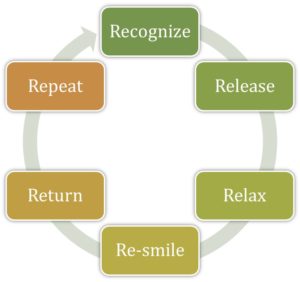Meditation
Meditation helps us to let go of difficult states in life such as fear, anger, tension, stress, anxiety, depression, sadness, sorrow, fatigue, condemnation, feelings of helplessness. These states result in suffering. This suffering is caused by ourselves as we do not understand how things or phenomena actually do occur. Yet successful meditation needs a very firm foundation, a prepared ground for wisdom to blossom.
The Buddha teaches us that we first must expand our consciousness by the practice of generosity and morality. A person, who is miserly, has often a tendency to have a tight and limited heart. The heart and mind must be loosened, much like the soil of a garden, and prepared properly through the practice of generosity. A generosity which comes from the heart.
Virtue and morality (not killing, not stealing, not lying, no sexual misconduct, no intoxication) release the mind from fear, anxiety, guilt, and remorseful feelings, if they are continually kept and observed. They fertilize the ground.
Only after firmly committing to the foundation of morality, all the time in our life, we move on to establish a successful practice of the meditation following the Buddha’s own words as close as possible. There a guiding teacher who understands how to present the information clearly in direct relationship with the meditation is most helpful.
Meditating diligently insights arise and wisdom follows and blossoms understanding the impersonal process of Dependent Origination and the Four Noble Truths. This is the heart the Buddhas‘ teachings where the flower blossoms.
three ingredients: morality meditation wisdom
Sati
Just as a royal frontier fortress has a gatekeeper—wise, experienced, intelligent—to keep out those he doesn’t know and to let in those he does, for the protection of those within, and to ward off those without; in the same way, a disciple of the noble ones is mindful, endowed with excellent proficiency in mindfulness, remembering & recollecting what was done and said a long time ago. With mindfulness as his gatekeeper, the disciple of the noble ones abandons what is unskillful, develops what is skillful, abandons what is blameworthy, develops what is blameless, and looks after himself with purity.”
AN 7.63
The Pali term sati or mindfulness is one of those words that everyone is supposed to know the definition of, but few people actually do as the definition of mindfulness has never been very clear. The Buddha never defined the term sati per se. But there are many references and definitions in context.
One part of its definition is to remember. Remember the instruction given in the past; remember what is right and wrong, what is wholesome and unwholesome; remember to watch the mind and to remember to observe whatever arises in the present moment; to remember to recognize any distraction that pulls our attention away from our object of meditation in the present moment and to remember to return to the object of meditation when we have wandered off.
The second part of mindfulness is the foundation or establishing of right mindfulness. Ardent and alert we observe how mind’s attention moves from one thing to another and how phenomena arise and pass away. Right mindfulness, hand in hand with right effort, enables us take an active and sensitive role to develop insight into the process of origination and cessation.
When right mindfulness becomes strong, we start begin understand the role craving plays. Craving is the moment when the mind likes something or does not like something and an identification process in which we take things personally is started. Craving pulls your mind away from your object of meditation and thoughts arise.
The establishing of right mindfulness or in easier terms mindfulness meditation is the process in which we observe how mind’s attention moves moment-to-moment and see clearly and precisely how the impersonal process of thoughts and sensations arises and passes away. Through mindfulness meditation an impersonal perspective on all arising phenomena is developed. This process leads us to see und fully understand the true nature of existence.
Metta
Metta is a Pali word and translates as lovingkindness, benevolence, active good will. Metta meditation is an active form of meditation where instead of focusing on the breath, or the body, or bodily sensations we focus on sending benevolent thoughts and wishes to ourselves, to others, and out into the universe. We imagine that the people in our minds are touched by our good will.
metta meditation instructions for beginners
Twim
The Buddha taught that for wisdom to arise we need to practice calm and insight, either one after the other or together. Tranquil Wisdom Insight Meditation (TWIM) is a practice in which calm and insight are developed together. It could also be described as mindfulness at metta. Right effort together with mindfulness is used in a sixfold way, hence his method is called the 6r practice.
When you are practicing TWIM, you do not suppress anything. Suppression means we would push down or push away or not allow certain types of experience. This would temporarily stop hindrances from arising. Instead, when a hindrance arises, you must work to open your mind by seeing you begin to see clearly how mind works. Wisdom is developed by seeing clearly impermanent, inherently unsatisfactory nature of things. Seeing clearly that it is just an impersonal process.
The 6r Practice
The six Rs is a method containing a cycle of 6 steps which with practice evolve into one fluid motion. This cycle begins when mindfulness remembers the six Rs. Mindfulness is the fuel on which the motor of the cycle runs. With practice this method will become a wholesome habitual tendency that relieves any dis-ease in mind and body.
Be alert or mindful with what arises in the present moment. Recognize any distractions that pull mind’s attention from the meditation object.
Let go of any thoughts, sensations or emotional feelings. Remember its O.K. for that thought, sensation, or emotional feeling to be there because that is the truth of the present moment. Allow the thought, sensation, or emotional feeling to be, without trying to make it be anything other than it is
Relax the tightness! Let go of the tight mental fist around the feeling and let it be. Tranquilize both body and mind.
Remember that this is a smiling meditation and it is helpful to smile as much as possible.
Come back to your object of meditation by gently re-directing your tranquil attention back to radiating the feeling of love, making a sincere wish for your happiness, and feeling that wish in your heart.
Continue on with your meditation of radiating loving kindness, making and feeling the wish for as long as you can.
Benefits of metta


